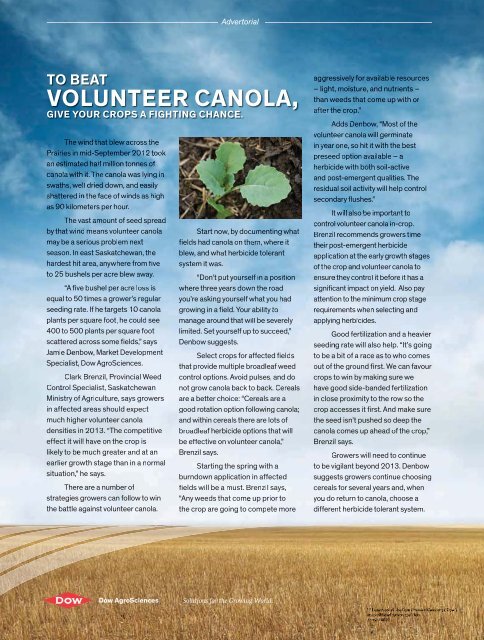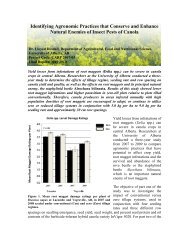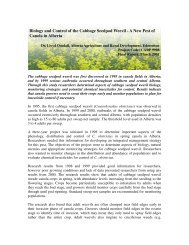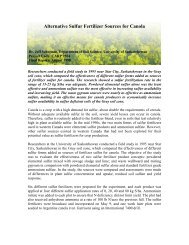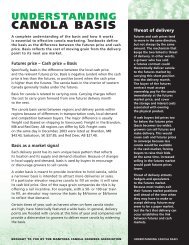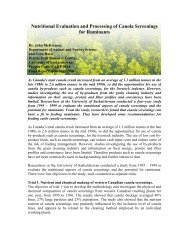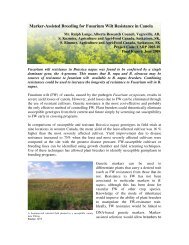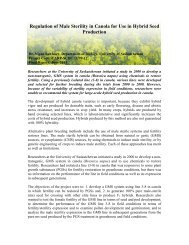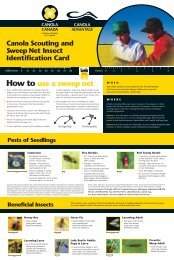Canola Digest, January 2013 - SaskCanola
Canola Digest, January 2013 - SaskCanola
Canola Digest, January 2013 - SaskCanola
Create successful ePaper yourself
Turn your PDF publications into a flip-book with our unique Google optimized e-Paper software.
Advertorial<br />
TO BEAT<br />
VOLUNTEER CANOLA,<br />
GIVE YOUR CROPS A FIGHTING CHANCE.<br />
The wind<br />
tha<br />
t blew<br />
acr<br />
cros<br />
s th<br />
e<br />
Pr<br />
airi<br />
ries<br />
in mi<br />
d-<br />
Se<br />
pt<br />
embe<br />
ber 20 12 too<br />
ook<br />
an est<br />
stimat<br />
ed hal<br />
alf mill<br />
llio<br />
ion tonn<br />
es<br />
of<br />
cano<br />
la wit<br />
ith it. Th<br />
e cano<br />
la was<br />
lyi<br />
ng in<br />
swat<br />
aths<br />
hs, well<br />
dri<br />
ed dow<br />
own,<br />
and<br />
eas<br />
asily<br />
sh at<br />
tere<br />
red in the<br />
fac<br />
ace of winds<br />
as high<br />
as 90 kilo<br />
meters<br />
per<br />
hour.<br />
Th<br />
e vast<br />
amo<br />
moun<br />
unt of<br />
seed sp<br />
read<br />
by that wind<br />
means volun<br />
teerer<br />
can<br />
anol<br />
a<br />
may be a ser<br />
erio<br />
ious<br />
probl<br />
blem<br />
nex<br />
t<br />
se<br />
ason<br />
on. In east Sask<br />
atchewan, the<br />
ha<br />
rdes<br />
t hit area, anywhere<br />
from five<br />
to 25 bush<br />
shel<br />
els pe<br />
r ac<br />
re ble<br />
lew away.<br />
“A five bushel per acre<br />
loss is<br />
equal to 50 times a grower’s<br />
regular<br />
seed<br />
eding rate. If he targets 10 can<br />
ola<br />
pl<br />
ants<br />
per square foot, he could see<br />
400 to 500<br />
plants per square<br />
foot<br />
scattered across<br />
som<br />
e fields,” says<br />
Jami<br />
mie Denb<br />
ow, Market<br />
Development<br />
Sp<br />
ec<br />
ialist, Dow AgroScienc<br />
es.<br />
Clark Br<br />
enzil, Provincial Weed<br />
Contro<br />
l Specialist, Saskatchewan<br />
Ministry of Agriculture, says growers<br />
in affected areas should expect<br />
much higher volunteer canola<br />
densities in <strong>2013</strong>. “The competitive<br />
effef ct it will<br />
have on the<br />
crop is<br />
likely<br />
to be much greater an<br />
d at an<br />
earlie<br />
ier growth stage<br />
than in a normal<br />
situation,” he says.<br />
There are a number<br />
of<br />
strategies growers can<br />
follow to win<br />
the battle against volunteerer can<br />
ola.<br />
Star<br />
art no<br />
w, by docu<br />
ment<br />
nting what<br />
fields had canola on them<br />
em, wher<br />
ere it<br />
blew, and what her<br />
bici<br />
de toler<br />
erant<br />
sy<br />
stem it was.<br />
“Don’t put<br />
yoursel<br />
f in a pos<br />
osit<br />
ition<br />
where three years down the road<br />
yo<br />
u’re askin<br />
ing yourself<br />
what you had<br />
growing in a field. Your ability to<br />
mana<br />
ge aroun<br />
und th<br />
at<br />
will be sev<br />
everer ely<br />
limited.<br />
Set<br />
you<br />
rsel<br />
elf up to succeed,”<br />
Denbow suggests.<br />
s<br />
Sele<br />
ct crops for affec<br />
ted fields<br />
that<br />
provide multiple broadleaf weed<br />
control options. Avoid pulses, and do<br />
not grow canola back to back. Cereals<br />
are a better choice: “Cereals are a<br />
good rotation option following canol<br />
a;<br />
and within cereals<br />
there are lots of<br />
broadleaf herbicide options that will<br />
be effective on volunteer canola,”<br />
Brenzil says.<br />
Starting the spring with a<br />
burndown application in affected<br />
fields will be a must. Brenzil says,<br />
“Any weeds that come up prior to<br />
the crop are going to compete mo<br />
re<br />
aggr<br />
gr<br />
essively<br />
for ava<br />
vail<br />
ilab<br />
able<br />
res<br />
ourc<br />
rces<br />
– ligh<br />
ght, moist<br />
sture,<br />
a nd nut<br />
utrients<br />
–<br />
than wee<br />
ds that come up with<br />
or<br />
afte<br />
ter the crop<br />
.”<br />
Adds<br />
ds Den<br />
enbo<br />
bow,<br />
“Mo<br />
Most<br />
of the<br />
volu<br />
lunt<br />
eer cano<br />
nola<br />
wil<br />
ill ge<br />
rmin<br />
ate<br />
in yea<br />
r on<br />
e, so hit it wit<br />
h th<br />
e best<br />
pres<br />
esee<br />
eed op<br />
tion<br />
ava<br />
vailab<br />
le – a<br />
herbic<br />
icide with<br />
bot<br />
h soil-act<br />
ive<br />
and post-emerg<br />
rgen<br />
t qu<br />
al<br />
itie<br />
ies.<br />
The<br />
resi<br />
sidu<br />
al<br />
soil activi<br />
ty wil<br />
ill help<br />
con<br />
ontr<br />
trol<br />
secondar<br />
ary flushes.”.<br />
It<br />
wil<br />
ill also<br />
be impo<br />
portan<br />
ant to<br />
co<br />
ntrol vo<br />
lunt<br />
ntee<br />
eer canola<br />
in-<br />
cr<br />
op.<br />
Brenzil recommends<br />
gro<br />
rowe<br />
rs time<br />
their post-emergent herbicid<br />
ide<br />
ap<br />
plication at the early<br />
growt<br />
wth st<br />
ag<br />
es<br />
of the<br />
crop and volunteer canola<br />
to<br />
ensure they control it before it has a<br />
sign<br />
gnifi<br />
ifica<br />
cant<br />
imp<br />
mpact on yield. Also pay<br />
attent<br />
ion to the<br />
minimum<br />
crop stage<br />
requ<br />
irements when selecting and<br />
applyi<br />
ng herbicides.<br />
Go<br />
od fertilization<br />
and a heavier<br />
seede ing rate will also help. “It’s<br />
going<br />
to be a bit of a race as to wh<br />
o come<br />
s<br />
out of the ground first. We can favour<br />
crops to win by making sure we<br />
have good side-banded fertilization<br />
in close proximity to the row so the<br />
crop accesses it first. And make sure<br />
the seed isn’t pushed so deep the<br />
canola comes up ahead of the crop,”<br />
Br<br />
enzil says<br />
.<br />
Growers will need to continue<br />
to be vigilant beyond <strong>2013</strong>. Denbow<br />
suggests growers continue choosing<br />
cereals for several years and, when<br />
you do return to canola, choose a<br />
different herbicide tolerant system.<br />
®<br />
TM<br />
Trad<br />
emar<br />
kof<br />
The Dow<br />
Che<br />
mica<br />
cal lCo<br />
Compan<br />
y(“<br />
Dow”<br />
)<br />
or ra<br />
an naf<br />
fili<br />
iated<br />
com<br />
ompany<br />
of<br />
Dow.<br />
1112<br />
112<br />
12-1<br />
-198<br />
99


